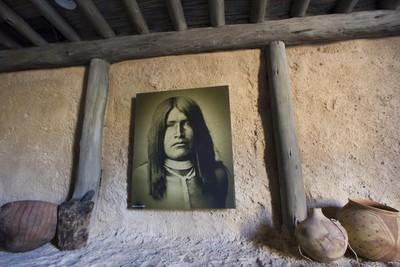FUN WAYS TO LEARN


The message at the Springs Preserve is clearly about considering the sustainability of the environment. But, said Jesse Davis, spokesman for the preserve, "It’s about fun more than anything else. It’s not designed to preach."
The preserve’s centerpiece is the ORI-GEN Experience, with more than 100 exhibits in three galleries, plus a theater. The 150-seat Big Springs Theater shows the film "Miracle in the Mojave," which serves as an orientation for preserve visitors. The theater also can be rented.
Galleries in the ORI-GEN Experience are the Natural Mojave Gallery, People of the Big Springs and the New Frontier. The exhibits all were custom-made for the Springs Preserve, Davis said, and the majority are interactive. The galleries are entered through a rotunda area over a floor with glass and perforated-steel panels, with a stream flowing beneath.
The Natural Mojave Gallery’s 26 exhibits depict the geological aspects of the area and its wildlife. It contains many man-made exhibits, including one that explains how desert animals move about, and one that demonstrates the geological development of the Las Vegas Valley. Visitors also will find live animals there.
In the bat cave, special effects mimic the experience of interacting with pallid bats, and live bats can be viewed through a window and on "batcams." In an underground grotto, visitors can see three Gila Monsters in their burrows. Younger visitors also can access a rabbit burrow and pop their heads up into bubble-shaped skylights to get a rabbit’s-eye-view of the world outside.
In the Desert Life Cycle Theater, visitors who find themselves standing at the foot of a canyon experience a flash flood as, first, the "weather" in the theater changes from pleasant to threatening, and then 5,000 gallons of recycled water suddenly rush toward them.
The 33 exhibits in the People of the Springs Gallery trace human habitation of the area over thousands of years. Among the gallery’s standouts is a historic rail car depicting passengers traveling by train, complete with windows showing what was then the passing view outside. In a life-sized vignette that’s a re-creation of the 1905 land auction, visitors can walk among figures and hear various snippets of conversation from parabolic speakers hanging above.
Reconstructed Indian structures from various eras also are part of this area. Davis said remains of an actual pit house that dates back 1,200 years were found on the site. Timelines and archaeological displays also are in this gallery, where everything in some way relates to water, including the progression of water use.
The New Frontier Gallery is a fun land of 13 games designed specifically for the preserve. In the Pac-Man-like Lawn Gobbler, the player races around gobbling up water-wasting turf and replacing it with xeriscaping. You Don’t Know Dewey is a water trivia game, and the Sustainables makes players superheroes who find and destroy creatures wasting household energy. Some have green screens, enabling the players to become part of the game.
The Desert Living Center is home to areas including the Sustainability Gallery, which presents graphic depictions of solutions to environmental challenges. They are, Davis said, "things visitors can do to change their daily living habits. There are some extremes, but some are already on the market."
There’s a Toyota Prius hybrid automobile and an electric bicycle. There’s a bathroom setting showing sources of water waste, and another display that demonstrates the power usage of different types of electric lights.
The Smart Shopper Game gives players a rating that tells whether they’re living in a sustainable manner, and the precarious-looking Tower of Trash illustrates how much an average Las Vegas family discards within a month.
Other displays provide guidance on picking fertilizers and irrigation systems.
And more. Much more. There’s a reference library. A design lab. Training center. Galleries for traveling and temporary exhibits. Far more than can be seen in a few hours, or even in a day.
At the Springs Preserve, visitors can relive the history of the Las Vegas Valley. But they also can look to the future, and find inspiration for making it better, Davis said.
"I think visitors are going to leave here feeling proud to be a Las Vegan."
RESTAURANT PLANS ORGANIC/SUSTAINABLE MENU The Wolfgang Puck restaurant that will open at the Springs Preserve toward month’s end is in keeping with the preserve’s pro-environmental philosophy and with Puck’s WELL Initiative, his mission for the next 25 years of his company. The WELL Initiative is an acronym for Wolfgang’s Eating, Loving and Living. "It was perfect for us, sustainable seafoods, sustainable living, sustainable products," said Carl Schuster, chief executive officer of Wolfgang Puck Catering. "Our whole concept there is to really take the casual dining concepts we do in a lot of our other restaurants and museums and really be 100 percent organic/sustainable, from what we serve it on to where it comes from to how the place was built. Even sourcing silverware. So it’s been an education, what we can do and what we can’t do." The menu will be seasonal to take advantage of the best the market offers, Schuster noted. It will include crate-free pork, crate-free veal and eggs from cage-free hens. Restaurant guests will order at a counter and take a marker to their table; the food will be brought there. Schuster said menu items will include heirloom tomatoes, sweet white corn soup and organic greens. The chopped salad, which Schuster noted is a Puck signature dish of many years, "works well with all the organic vegetables." There will be Puck’s signature Chinese chicken salad and a wild-caught barbecued salmon BLT. One station will serve five pizzas, including four-cheese, spicy shrimp and grilled vegetable. HEIDI KNAPP RINELLA/REVIEW-JOURNAL











